Walking around Prague, you’re bound to see ‘Czech Cuisine’ or ‘Česká kuchyně’ on signs and blackboards outside pubs and restaurants. If you’ve never tried Czech cooking, you might be wondering what it is all about. By no means comprehensive, the following examples are some of the main dishes that are associated with Czech cuisine.
Main Dishes
There’s no getting away from the generalization that traditional Czech cuisine is heavy. We’ve all probably read a description which points out that many dishes are meat-based, with thick, often creamy sauces served with carb-laden sides such as dumplings or potatoes. For a lot of the national dishes, these features are pretty standard.
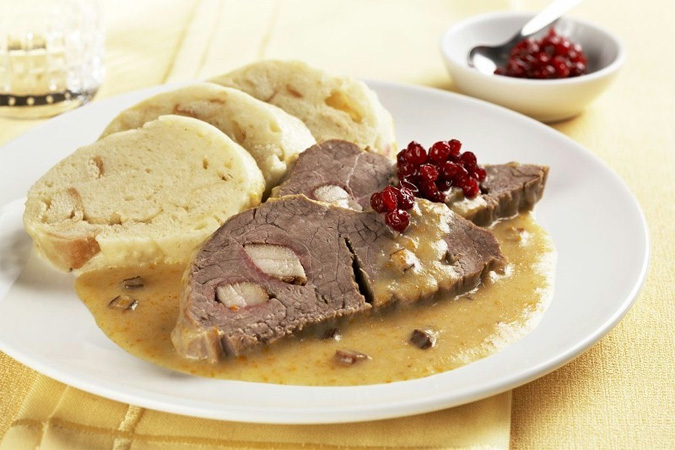
Svíčková na smetaně
Take for instance the pride of Czech cuisine, svíčková na smetaně. This dish, which is translated as ‘Beef Sirloin with Cream Sauce’, has some variation, especially when comparing the home-cooked version with what you get in the pub. But even the quality and taste varies from pub to pub. Generally, the side of sirloin is marinated and then roasted with root vegetables and onions. Once the meat is ready, the vegetables and šťáva (meat juice) are removed and pureed. Cream and flour are added to the puree to make the sauce. The meat is sliced and served with the sauce, bread dumplings, and a slice of lemon with whipped cream and cranberry sauce. Though the name derives from the particular of cut of meat, the term svíčková can refer to the sauce and can be served with other meats such as venison and roasted hare. It packs a few calories, but when done well, especially home-cooked, it is delicious and perfect as a hearty meal in the cooler months.
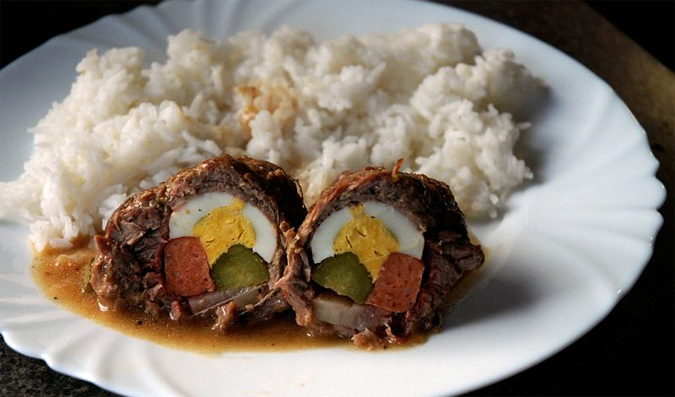
Španělský ptáček
An equally tasty variation on the meat in sauce is Španělský ptáček (Spanish bird). There is no bird in this dish, rather thin slices of rump or sirloin that have been beaten thin and wrapped around long slices of pickle, bacon, egg, and/or onion. The ‘birds’ are then roasted in stock, which is the basis of the sauce. Often, the dish is served with boiled plain rice. Again, the recipe will depend on the chef, and usually a home-cooked ptáček is superior to those in restaurants.
On the subject of sauces, two popular ones are rajská omáčka and koprová omáčka. Rajská omáčka is a smooth tomato sauce, with a somewhat similar consistency and occasionally taste of tomato soup depending on where you get it. The sauce is served with a piece of beef. As you might guess, I wasn’t sold on rajská (as it is simply called) until I had a home cooked version, which was significantly tastier than what I had in restaurants. If there is a restaurant out there that does good rajská, I’d be keen to know. Koprová omáčka – dill sauce – is usually more satisfying. This slightly sour sauce is made from dill cooked in butter, cream, flour, and a little vinegar. Again, it’s often served with beef, but you can also have it on its own over dumplings or with hard-boiled eggs.
Personally, I prefer the rajská with stuffed peppers (plněné papriky), which are white peppers – the long, light green ones – stuffed with mincemeat. The sauce and the peppers are made for one another. You can also find them topped with cheese and bacon.
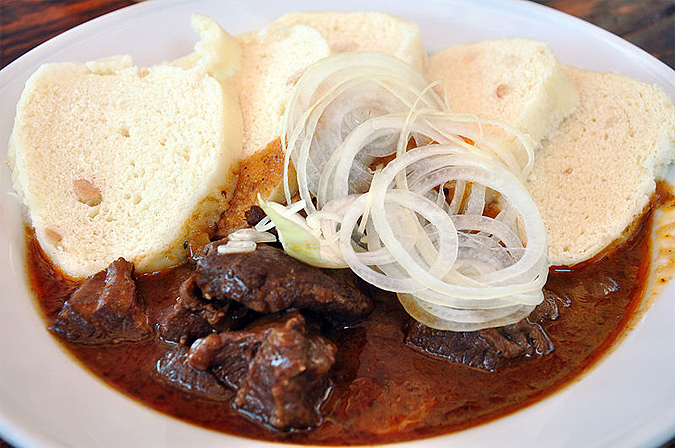
Hovězí guláš
Goulash (guláš in Czech) is a common dish in pubs. The name actually hides a variety of types, though the most common will be large pieces of beef in a thick, mildly spicy sauce. It can be served with raw sliced onion and horse radish. Hungarian goulash (maďarský guláš) is a deep, richer red from paprika. (Though the Czech and English versions get their name from the Hungarian gulyás, this is more of a soup. The Czech version is closer to the Hungarian pörkölt.) A variant on this is pikantní guláš, which as the name suggests is spicy, though not really hot. Segedínský guláš contains pork, instead of beef, and cabbage.
I’ve been told that the typical Czech dish is Vepřo, knedlo, zelo – roast pork, dumplings, and sauerkraut. The name says it all. The meal is usually served with the jus from the meat. You are more likely to find this in canteens than pubs.
A variation on roast pork – and another dish named after birds – is Moravský vrabec or Moravian sparrow. The ‘sparrows’ are pieces of pork shoulder or belly, roasted with garlic and cumin and served with potato dumplings and pureed spinach. This dish is another one quite typical of canteens. Its taste comes down to the quality of the meat and the dumplings.
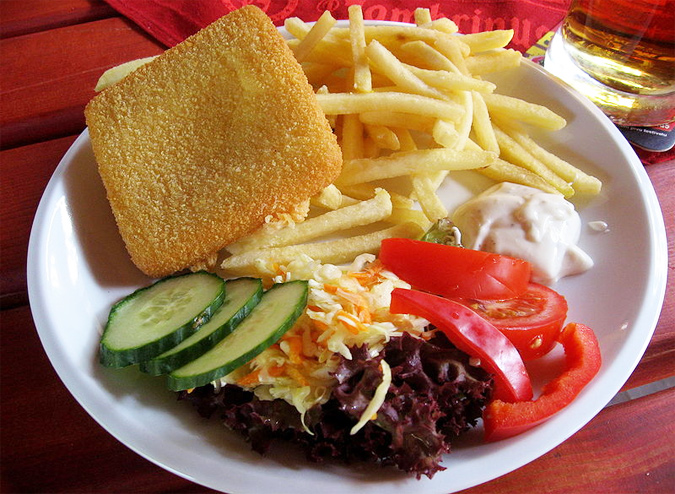
Smažený sýr
Though many of these dishes contain meat, there are a few Czech vegetarian meals. The only problem is that they are all fried. These are fried cheese (smažený sýr) popularly known as smažák, fried mushrooms (smažené žampiony) and fried cauliflower (smažený květák). These dishes are often served with fries and tartar sauce.
Side Dishes
Dumplings (knedlíky) are certainly one of the hallmarks of Czech cuisine. They come in a few varieties. Houskové and bramborové – bread and potato – are the two most common. Bread dumplings are more often served with sauces, which they are perfectly designed to soak up. The potato dumplings are often the side of roasted or smoked meat, though this is not set in stone. Špekové knedlíky are made with fatty bacon, and are not so widely eaten. Fruit dumplings (ovocné knedlíky) are filled with different fruits but more often plums, apricots or blueberries and served with quark or poppy seeds. Though sweet, they are often eaten as a main course.
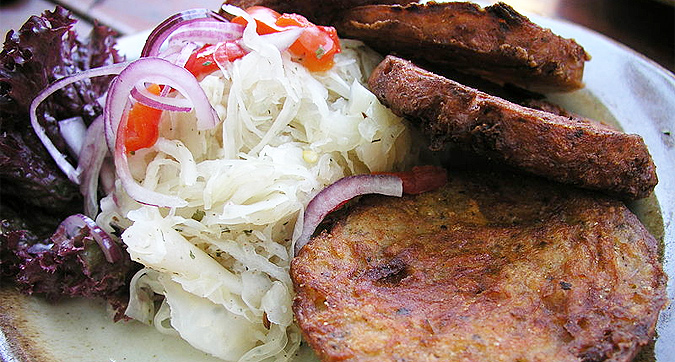
Bramboráčky
Potatoes prepared in a number of ways are another staple in local cooking. The ever popular tuber is served boiled (vařené), roasted (pečené), served as fries (hranolky), wedges (Americké) or made into pancakes (bramboráčky). The latter are even eaten alone, though they’re good with sauerkraut and steamed ham. Czech potato salad is a popular accompaniment for schnitzel or with the traditional Christmas carp.
Soups
At the risk of making another generalization, soups are a fairly important part of Czech meals. When you order a lunch special in many restaurants, soup is included, and no Sunday lunch would be complete without one. Given the popularity of soup, the range is hardly surprising. Here is a list of some of the more common ones.
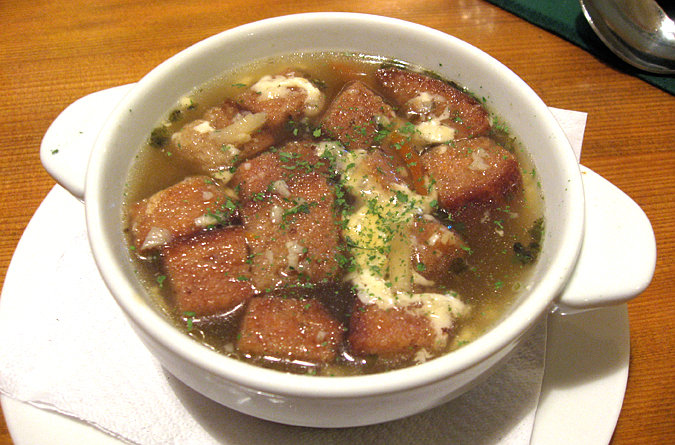
Česnečka
Česnečka: this strong garlic soup is a local favorite. Traditionally, the soup is served with croutons, grated cheese, and small pieces of ham. Other versions can be served with egg, though this doesn’t seem so common in most restaurants.
Vývar is Czech for consommé. Usually, the stock is made from beef and the soup is served with thin noodles, small pieces of beef, vegetables, and sometimes liver dumplings (játrové knedlíčky).
Bramboračka is a hearty soup ideal for winter. It is made from potatoes, carrots, celeriac, and root parsley. Sometimes wild mushrooms are added, making it an extra special treat.
Dršťková polévka, or tripe soup, is obviously not to everyone’s taste, but when done well with the right amount of spice (and the tripe properly cooked), is another good and filling soup, though it’s availability doesn’t reflect its popularity.
Hrachová polévka is another hearty dish. Usually, the soup is made from dried green peas and served with croutons.
Pub Food
Unsurprisingly, a nation which is famous for its beer has some very tasty pub snacks, often called něco k pivu (something with beer). The keyword for Czech pub food is pickled – though not necessarily in vinegar.
Utopenci is of the most amusing names. It literally means ‘drowned men’, though the men are in fact plump špekáčky (short, fat pork sausages) stuffed with onions, bay leaves, and pickled in vinegar and spices.
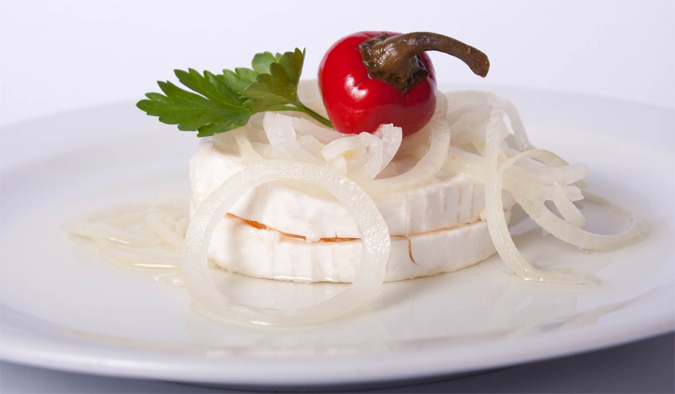
Nakládaný hermelín
Nakládaný hermelín is a brie-style soft cheese pickled in oil with spices. The cheese is usually cut through the center and the halves spread with crushed garlic. Often, the cheese is served with a chili.
Tlačenka is made from off-cuts pork and pig offal, which are boiled in stock and poured into long plastic tubes to make a long very thick block, usually 10- 15cm across, marbled with pieces of meat. The sausage is cut into 1.5 cm thick portions and served with slices of onion and vinegar. Tlačenka is a typical dish as part of a Czech zabijáčka.
Tatarský biftek, or more often simply Tatarák, is more a meal than a snack, but it also goes well with beer. If you have guessed or aren’t familiar, this is steak tartar – raw mince served with raw egg, onions, and a variety of sauces to season the mince. The Czech version is usually served with topinky – fried bread.
If you’re curious to try any of these or other Czech dishes, see Brewsta’s article for his pick of Czech restaurants in Prague. Dobrou chuť!
One last note about the Czech cuisine discussed in this article: while it may be traditional, it doesn’t mean all Czechs eat it. But when the words ‘traditional Czech cooking’ are used, many of these dishes feature.
What’s your favorite Czech dish? Let us know your thoughts on Czech cuisine in the comments section below!












 Reading time: 7 minutes
Reading time: 7 minutes 

 English
English
 Italian
Italian
 Swedish
Swedish
 Polish
Polish
 French
French
 Danish
Danish
























